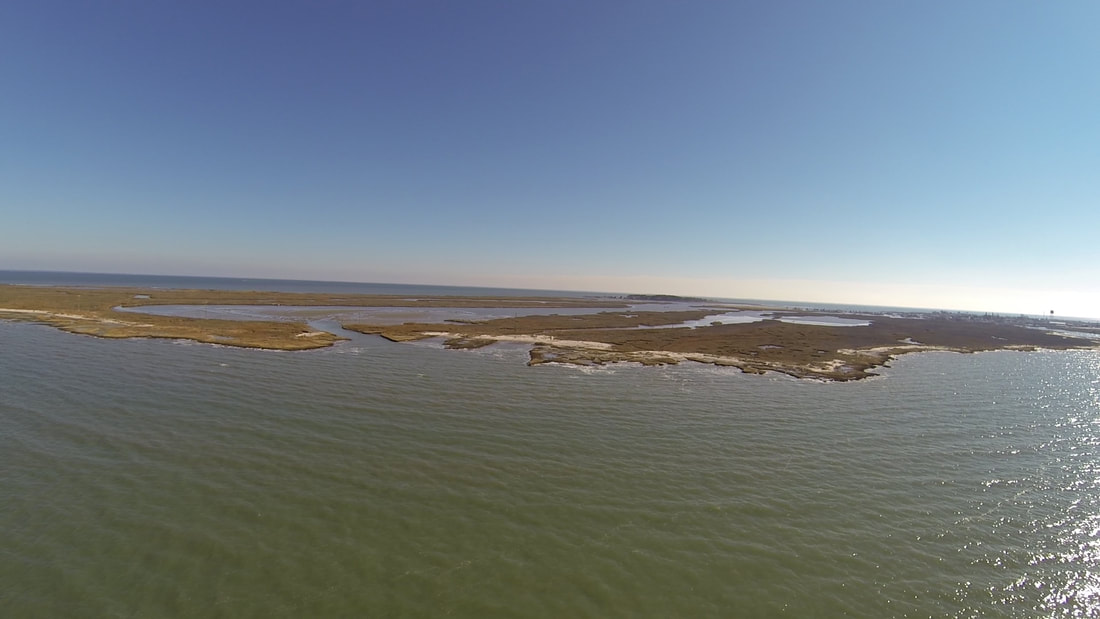 Most of the material in this post is taken out of the excellent book Chesapeake Requiem by the writer Earl Swift published in 2018. Mr. Swift lived for one year on the island of Tangier in the Chesapeake Bay. His book is a fascinating look at what is essentially the life and times of a small town whose economy is mostly reliant on the sea. He also describes in detail the rough life of the watermen, the men who risk their lives out in the water to catch the crabs and oysters consumed by Americans, and the ins and outs of their trade. But most importantly for the purpose of this blog, the author also extensively documents the plight of Tangier Island: it is disappearing. From the 1930s to the present day, two thirds of the island has been lost to the sea, and the pace of sea level rise in the Chesapeake Bay is accelerating. By the year 2050 Tangier may be by and large uninhabitable like other islands in the past that have experienced this fate in the Chesapeake Bay such as James Island, Sharps Island, and Holland Island. Because Tangier’s demise is happening in modern times when climate change has been identified as a worldwide problem, islands like Tangier are in a sense the “canary in the coal mine” of climate change, letting us envision on a small scale what will happen to coastal communities worldwide in the future. However, despite the certainty of these scenarios, scientists and climate change activists are mesmerized by the fact that the inhabitants of Tangier do not identify climate change as the root of their problems. The mayor of Tangier, James Eskridge, in 2007 had a face off in a televised town hall meeting with no other than environmental icon and former vice president, Al Gore. Mr. Eskridge explained his position (which turns out to be the same position of other communities in the Chesapeake Bay) that the problem they are facing is not sea level rise due to climate change, but rather erosion. He stated that he has a crab house business out in the water that was built in 1970, and in all this time he had not seen the sea-level rise that scientists claim to have occurred. Gore replied that scientists have documented that sea level in the Chesapeake Bay has indeed risen. However, he acknowledged that one of the challenges scientists have is translating this information to people in ways that are believable to them. Part of the issue is that the Tangier Island community is as conservative as they come. For example in 1946 when the congregation of the island’s only church attempted to remove a pastor deemed too progressive, the pastor left and founded a new church on Tangier. This event which split families apart led to widespread lawlessness ranging from acts of theft and vandalism to mobs of people throwing projectiles at the site of the new church’s building. The Methodist congregation in the island split again in 2011 over the belief that the broader United Methodist Church organization was becoming too liberal and did not support Israel enough. This led to a few tense years when some people in the island refused to talk to others. The town’s council once denied permission to Warner Brothers’ studio to film some scenes in Tangier of a romantic drama called “Message in a Bottle” because the movie contained cursing, alcohol drinking, and a sex scene. In the 2016 election, 87% of the population of Tangier voted for the now president of the United States, Donald Trump; an individual who has stated that climate change is a hoax.  Tangier Island Tangier Island In Tangier, the scientific establishment is in general viewed with distrust. This distrust has partly been fueled by climate change skeptic pundits who exploit conservative people’s fears by equating those who accept climate change and want to do something about it with atheists, liberals, and socialists. The people of Tangier would rather believe their own interpretation of what they have seen out on the water, than measurements taken by water stations, satellite data, or computer models. However, despite this, it is their belief in God and their ways which have allowed the inhabitants of Tangier to surmount many challenges. Among these are hurricanes have flooded and destroyed structures in the island (the highest part of the island is 4 feet above sea level), ghastly squalls, and other incidents that have taken the life of several watermen over the years, and fluctuations in the abundance of the crab and oyster populations and how much the market is willing to pay for them. The resilience of the Tangier community has been as remarkable as the strength of their faith. It could be argued that whether the cause of loss of land in Tangier is climate-change driven sea level rise or erosion is irrelevant, the important thing is to do something about it and save the island. Many have tried, but more often than not the plans for several projects to protect the island through the years have been bogged down in exasperating red tape and endless studies and studies of studies carried out by the US Corps of Engineers. Finally, the construction of a jetty to project Tangier’s Western shore was approved and will become a reality in this year, but many argue that in the long term this will not protect Tangier from the rising sea levels in the Chesapeake Bay. Some in the Tangier community think that the argument that climate-change driven sea level rise is to blame for their land loss problem and not erosion, is put forward to justify not doing anything about it. But the reality may be far crueler than that, and this is a quandary that many governments will have to face in the future. The quandary is: how much spending is justified to save a community? The island of Tangier has a population of 500 plus people. How many millions of dollars should be spent to save it as opposed to relocating the population elsewhere? In an era of mounting national debt and fiscal deficits, a lot of tough decisions will have to be made as coastal communities throughout the United States are threatened by rising sea levels. President Trump phoned the mayor of Tangier in 2017 and told him not to worry about sea level rise, adding that Tangier has been there for hundreds of years, and that he believes it will be there for hundreds more. Mr. Swift doesn’t seem to share that optimism, as we can surmise from the name of his book. Whether you are interested in science, government policy, or climate change activism, I highly recommend that you read it. I have only mentioned those aspects of the book that I deem relevant to this, a science blog. However, Chesapeake Requiem is much more than that. From the headstones of vanishing graves in old cemeteries being devoured by the sea to the ways of catching, classifying, cooking, and eating crabs, Mr. Shift describes for posterity a community that is now literally “living on a prayer”, a few decades away from oblivion. If you accept the reality of climate change, Tangier is the future, and it doesn’t look pretty. The image of the cover of the book Chesapeake Requiem is copyrighted and used here under the legal doctrine of Fair Use. The picture of Tangier from the US Army Corps of Engineers website is considered public information and may be distributed or copied.
0 Comments
 I once attended a presentation given by the Dalai Lama to an audience of scientists. In this presentation he relayed an anecdote of something that happened during the years when he trained to be a monk. He said that one of his teachers had stated that the moon shone with its own light. Sometime later, the Dalai Lama learned about the knowledge that the moon does not emit a light of its own, but rather that it reflects light from the sun. So he had to go back and correct his teacher. The Dalai Lama used this as a stepping stone to go on to suggest that our beliefs must be tempered by science. In other words, if we believe something and science produces solid evidence against it, then we must stop believing in it. To many people this would sound presumptuous. Why should science be the ultimate arbiter of truth? Isn’t science sometimes wrong? The answer is, of course, that science can be wrong, but as it turns out that is its strength. The reason that science is the best method we have to discover the truth about the behavior of matter and energy in the world that surrounds us is that, unlike other modalities of learning the truth, science can be wrong. Let me explain.  The above notion was put forward by the great philosopher of science Karl Popper. Popper was striving to find a way to tell science apart from other non-scientific disciplines, and he came up with a brilliant solution which he called the “criteria for demarcation”. Science makes testable claims. And because the claims of science can be tested, they can be proven to be wrong! This is also called the “falsifiability criterion”. While non-scientific disciplines produce theories that cannot be proven wrong and thus can never be tested or challenged, truly scientific disciplines propose theories that can be tested and unambiguously proven to be wrong if in fact they are. As an example, consider the case of polywater. This was a form of water that scientists were able to create inside small capillary tubes. This form of water had very different properties from regular water, and the international scientific community got really excited about its potential physical significance and applications. This went on until someone demonstrated that polywater was an unusual form of water because it was contaminated: it was dirty water! Thus the theory that polywater was a unique form of water was abandoned because it was challenged and proven false. Many scientific theories have met this fate, but this happened because they were testable. They could be proven to be false. In contrast consider Creationism. This discipline has been challenged and proven false many times. Its proponents, rather than concluding that creationism is false, have proceeded to change the theory and reformulate it is a new guise over and over. Creationism cannot be proven wrong because its proponents are not willing to stake the viability of the theory on specific testable claims. Therefore creationism is not a scientific discipline. On the other hand consider the theory of evolution. This theory has been put to test many times from many different directions, and it has survived those challenges. Today evolution has become a pillar of the biological sciences, and scientist have moved on from discussing whether evolution is true or not to applying the tenets of evolution to many areas of science that are producing discoveries that are making our lives better. The above also highlights another quality of science: it is self-correcting. In the short run scientists may make mistakes and propose incorrect hypotheses, but these hypotheses will be challenged and, if they are false, they will be proven to be so. Finally, I want to point out a real life practical application of the above knowledge that you can take away from having read this article. If you are ever witnessing a discussion where the arguments and counter arguments seem to go on forever and it is not clear who is right, just ask the following question: what evidence will convince you that you are wrong? If the parties involved in the discussion cannot unambiguously answer this question and commit themselves to changing their opinion based on whether such evidence is produced, then what you are witnessing is not a scientific discussion. This is not to say it is not an important discussion, but it does mean it will never be resolved based on evidence and facts. The photograph of the Dalai Lama was taken by Christopher and is used under a Creative Commons license. The photograph of Karl Popper by Lucinda Douglas-Menzies is in the public domain. |
Details
Categories
All
Archives
June 2024
|
 RSS Feed
RSS Feed